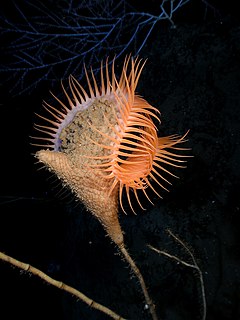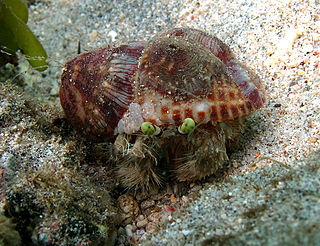
Stichodactylidae is a family of sea anemones that contains the genera Stichodactyla and Heteractis. These sea anemones exclusively reside within the shallow waters of the tropical Indo-Pacific area and are in the main family of sea anemones that hosts several varieties of clownfishes. Most sea anemone species are harmless to humans, but at least some Stichodactyla are highly venomous and their sting may cause anaphylactic shock and organ failure. In contrast, the venom of Heteractis has shown potential in treatment of lung cancer.

Actiniidae is the largest family of sea anemones, to which most common, temperate, shore species belong. Most members of this family do not participate in symbioses with fishes. Three exceptions are the bubble-tip anemone, snakelocks anemone and Urticina piscivora.

The Venus flytrap sea anemone is a large sea anemone that superficially resembles a Venus flytrap. It closes its tentacles to capture prey or to protect itself. It is a deep ocean species.

Hexacorallia is a class of Anthozoa comprising approximately 4,300 species of aquatic organisms formed of polyps, generally with 6-fold symmetry. It includes all of the stony corals, most of which are colonial and reef-forming, as well as all sea anemones, and zoanthids, arranged within five extant orders. The hexacorallia are distinguished from another class of Anthozoa, Octocorallia, in having six or fewer axes of symmetry in their body structure; the tentacles are simple and unbranched and normally number more than eight. These organisms are formed of individual soft polyps which in some species live in colonies and can secrete a calcite skeleton. As with all Cnidarians, these organisms have a complex life cycle including a motile planktonic phase and a later characteristic sessile phase. Hexacorallia also include the significant extinct order of rugose corals.
Dactylanthus may refer to:

The starburst anemone or sunburst anemone is a species of sea anemone in the family Actiniidae. The sunburst anemone was formerly considered the solitary form of the common aggregating anemone, but was identified as a separate species in 2000.

Sea anemones are a group of predatory marine animals of the order Actiniaria. Because of their colourful appearance, they are named after the anemone, a terrestrial flowering plant. Sea anemones are classified in the phylum Cnidaria, class Anthozoa, subclass Hexacorallia. As cnidarians, sea anemones are related to corals, jellyfish, tube-dwelling anemones, and Hydra. Unlike jellyfish, sea anemones do not have a medusa stage in their life cycle.

Phymanthus crucifer, commonly known as rock flower anemone, flower anemone, red beaded anemone or the beaded anemone, is a species of sea anemone in the family Phymanthidae. It has been described as "closely similar" to Heteractis aurora in several ways, commonly exhibiting "tentacles with swollen cross-bars" bearing large clusters of stinging nematocysts. However, P. crucifer may also be found with smooth tentacles, sometimes in the immediate vicinity of a swollen-crossbarred specimen.

Preactiniidae is a family of sea anemones in the order Actiniaria The family contains two species in two monotypic genera.

Urticina eques is a species of sea anemone in the family Actiniidae. It is commonly known as the white-spotted rose anemone or strawberry anemone.

Metridium farcimen is a species of sea anemone in the family Metridiidae. It is commonly known as the giant plumose anemone or white-plumed anemone. It is found in the eastern Pacific Ocean from Alaska down to Catalina Island, California.

Boloceroides daphneae is a cnidarian which occurs in the depths of the East Pacific Rise and was described in 2006.
Actinernoidea is a superfamily of sea anemones in the order Actiniaria, Until 2014, this taxon was considered to be a separate suborder of the family Actiniaria.

The Enthemonae is a suborder of sea anemones in the order Actiniaria. It comprises those sea anemones with typical arrangement of mesenteries for actiniarians.

Metridioidea is a superfamily of sea anemones in the order Actiniaria.
Urticinopsis antarctica is a species of sea anemone in the family Actiniidae. It is found in the Southern Ocean around Antarctica.

Actinostola is a genus of sea anemones in the order Actiniaria. All members of this genus are deep-sea species, with some occurring at hydrothermal vents.
Paranemonia vouliagmeniensis, or Greek anemone, is an endangered sea anemone that occurs only in Lake Vouliagmeni, Athens. The lake's status as a spa has contributed negatively to the species' livelihood and population; while no formal population monitoring has taken place, it has been estimated that the population has decreased by over 50% from 2007-2017. Paranemonia vouliagmeniensis has large embryos that can be found in the tentacles, unlike other species in the same genus. It also has a greater size range than other sea anemone.

Cricophorus nutrix, commonly known as the brooding or nurseanemone, is a species of sea anemone endemic to New Zealand.

Dardanus deformis is a species of nocturnal hermit crab that is found in the Indo-Pacific. Its common name is pale anemone hermit. The species is known to transfer sea anemones from one shell to another when it moves to a different shell. It can be kept in an aquarium.














